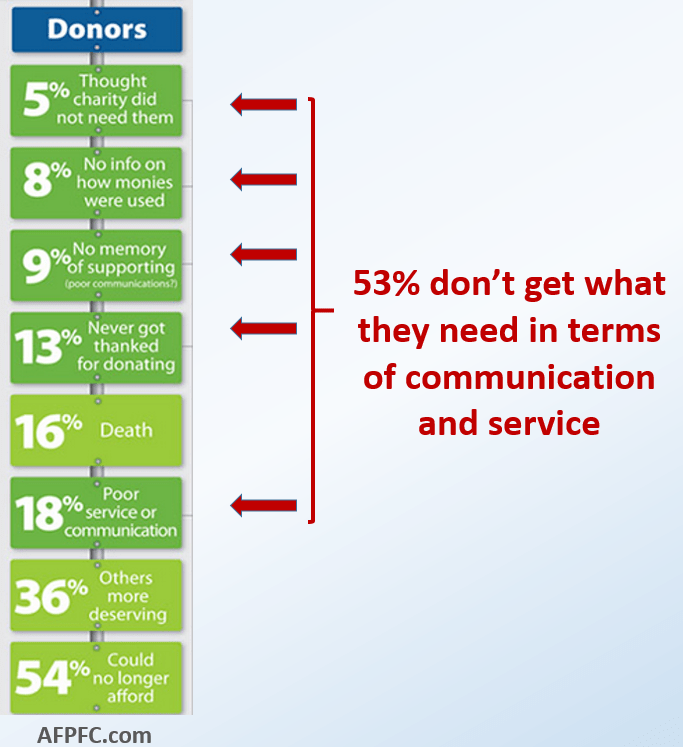
Progress is transformational. When you arrive, you feel good.
Greg Warner of Market Smart writes a lot about the difference between “work” and “progress.” I appreciate the distinction, both professionally and personally. I think you can use this notion, so I’m going to recommend some of his articles to you and also suggest a way to extend this idea to your nonprofit fundraising.
Warner notes in Why You Should Never Get a Job and Go to Work: “work” is tedious and negative; “progress” is inspiring and positive.
This is about being intentional about where you’re going.
It’s somewhat about perception and desitnation, but I’d argue it’s largely about the journey.
Your journey. Your donor’s journey.
Work is transactional.
You check things off a list. Need to do this/did this. Check! And then you move on to the next thing on the list. It never ends. Tiresome. Enervating. Dull.
Transactions offer a sense of accomplishment, but it’s generally fleeting.
Progress is transformational. You move towards a desired outcome. When you arrive, you feel good. You’ve achieved something meaningful.
Progress sounds a lot like good fundraising, don’t you think?
Work sounds more like bad fundraising.
Bad fundraising is transactional.
One-shot deals. Ask for money/receive money. Check! And then you move on to the next ask. It never ends. Tiresome for your donor. Enervating. Dull.
The sense of accomplishment quickly evaporates, because it never transforms into something heartfelt and meaningful.
Transactional fundraising is why donor retention has been abysmal over the past decade. The most recent Fundraising Effectiveness Project research shows, on average, nonprofits retain only 45% of all donors – less than half! For new donors, it’s less than a quarter. Why does this happen?!
Donors aren’t made to feel they accomplished much of importance.
As a result, they give up. Not on philanthropy. But on your nonprofit. Because… what’s the point in sticking with you?
You don’t make your donor feel good.
You don’t show them how their giving created a meaningful, positive impact – one that wouldn’t have happened without them!
You don’t make your donor the hero.
You send messaging that’s all about you, not them. About how great your organization is… what you did… what you’re doing… how great the need still is.
The donor can’t easily see their place in this narrative.
So they go find another story to enter into. Elsewhere. With an organization that does a more effective job creating a purposeful, transformative donor experience.
Progress is transformational.
It moves towards something intentional. To paraphrase Lewis Carroll in Through the Looking Glass: If you don’t know where you’re going, you’ll very likely get there.
Getting nowhere (fast or slow) is not a lot of fun. It’s the essence of the proverbial rat race. Without intention, life can be an exhausting treadmill proposition.
Warner writes: “Making progress helps you find meaning in your life.”
If you ever feel you want to stop the world and get off, consider that may be what your transactional donors are feeling vis a vis your organization.
Uh oh.
Good fundraising is transformational.
Guess what? The heart of your job as a nonprofit do-gooder is not to take money from folks; it’s to give folks purpose. This is why, if you’ve read or listened to me much at all, you’ll notice I constantly say: If you want gifts, you must give them.
Good fundraising helps donors find meaning in their lives.
This is the journey you must be on, because it’s the journey your would-be donors are on. They’re on an existential quest to discover their purpose. And you’re their Sherpa.
The best fundraisers are engagement experts.
They think beyond asking for and getting money in just this moment. They think beyond this trek and onto the next. They imagine strategies that will influence others to join the journey. They are always one step, or more, ahead.
Making progress.
Good fundraising is communicative and experiental.
 Groundbreaking donor-centered research by Penelope Burk revealed how vital donor communications are to retention and upgrading. At the core of this work is the finding that 93% of donors would definitely or probably give again if you communicated with them more effectively; 64% would give more.
Groundbreaking donor-centered research by Penelope Burk revealed how vital donor communications are to retention and upgrading. At the core of this work is the finding that 93% of donors would definitely or probably give again if you communicated with them more effectively; 64% would give more.
Sadly, numerous research reports reveal more than half of donors don’t get the communication they need to want to stick with you. [See here (Millennials) and here (long-term benefits of social causes) for two examples].
It’s really not that difficult to give donors a transformative experience.
You just need to commit to making everything about showing progress.
TO-DO: Build a robust gratitude program:
Here are a few basic things you need to give donors the positive feedback that will make them stick with you:
- You need to be prompt – thank within 48 hours.
- You need to be personal – no ‘form’ letters – people build relationships with other people; not with organizations.
- You need to change your thank you letter frequently.
- You need different thank you letters for different campaigns.
- You need different thank you letters for different donor segments.
- You need to thank more than once, preferably from different people.
TO-DO: Build a donor relationship strategy.
Here are a few basic things you need to make progress in retaining and upgrading more donors:
- You need to always think from your donor’s perspective.
- You need effective donor communications that tell inspiring stories.
- You need to use digital marketing and peer-to-peer tools.
- You need integrated marketing and fundraising
- You need a comprehensive stewardship
- You need to connect with donors frequently.
- You need to use the word “YOU” a lot.
- You need to ask donors about their preferences.
Maybe it’s time to stop building “Work Plans.”
When you build a plan that makes you sigh and dread having to implement it, that’s not a good sign.
It screams: Drudgery Ahead!
Instead of stringing a bunch of chores together, why not create a “Progress Plan?”
One that screams: Exhilarating Movement and Growth Ahead!
Warner resolved personally to seek a path “that delivers value to humanity and feels right for me and others.” Can you take a similar stance with your donors? Surely your nonprofit mission is one that delivers value to humanity, yes? So all you have to do is give your donor credit for also being an actor in delivering this value. Because that’s what will ‘feel right’ for them.
Stop treating donors like bystanders or bit players. They’re the heart and soul of your mission.
Help donors make progress on their journey towards meaning, and they’ll likely reciprocate by helping you make progress towards your mission and vision.
Without your donors, there’s little progress to be had.
BOTTOM LINE:
When you make progress, you’re happy.
When you help donors make progress, they’re happy.
When donors are happy, you’re happy.
And the circle continues.
When people ask you where you are going in the morning, you should never say, “I’m going to work.” Instead, tell them, “I’m going to make progress.”
–Greg Warner, Market Smart






Thank you for the very informative article. It would be great to read more about the common practice of transactional fundraising that rewards donors with brass plaques and public memorials. These legacy inducing vanity plates proliferating throughout our communities are toxic little reminders of the vast economic divide and that contributions from the less affluent, however generous, do not measure up. According to the transformational ideal, these vanity gifts are unnecessary and counter-productive for recipient organizations as well.
Thanks for your feedback. I prefer not to judge a donor’s motivations for giving. The heart of fundraising is the value for value exchange. The donors give something of value, money or time, and the charity gives back something of value to that donor. Done well, this can be transformational. The value given back can be any number of things, depending on the donor’s motivations. It may be an intangible feel-good. Or the sense of fulfilling a moral or religious obligation. Or paying it backwards or forwards. Or seeing their name in lights. Or… The point is there is nothing wrong to focus on what the donor gets out of this. Giving is not always its own reward. It is incumbent on the fundraiser to think from the donor’s perspective, and in that manner to facilitate philanthropy – love of humankind. We should endeavor to give value to donors of all sizes of gifts.